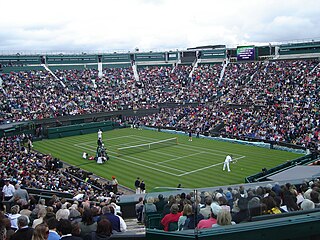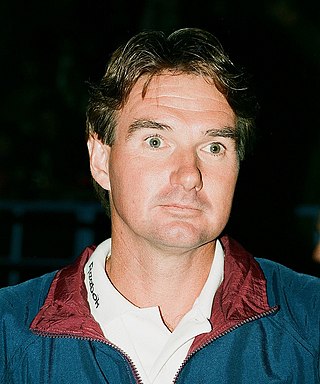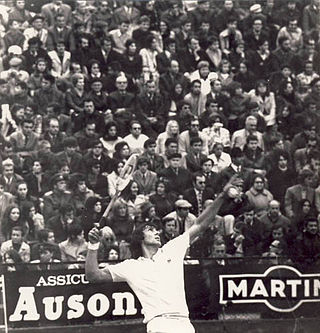
Ivan Lendl is a Czech-American former professional tennis player. He is widely regarded as one of the greatest tennis players of all time. Lendl was ranked world No. 1 in singles for a then-record 270 weeks and won 94 singles titles. He won eight major singles titles and was runner-up 11 times, making him the first man to contest 19 major finals. Lendl also contested a record eight consecutive US Open finals, and won five year-end championships. Lendl is the only man in professional tennis history to have a match winning percentage of over 90% in five different years. He also had a comfortable head-to-head winning record against his biggest rivals, which translates to a 22–13 record against Jimmy Connors and a 21–15 record against John McEnroe. Lendl's dominance of his era was the most evident at the year-end championships, which feature the eight best-ranked singles players. He holds a win–loss record at the event of 39–10, having contested the final nine consecutive times, a record. Commonly referred to as the 'Father Of Modern Tennis' and 'The Father Of The Inside-Out Forehand', Lendl pioneered a new style of tennis; his game was built around his forehand, hit hard and with a heavy topspin, and his success is cited as a primary influence in popularizing the now-common playing style of aggressive baseline power tennis. After retirement, he became a tennis coach for several players; in particular, he helped Andy Murray win three major titles and reach the world No. 1 ranking.

Kenneth Robert Rosewall is an Australian former world top-ranking professional tennis player. Rosewall won 147 singles titles, including a record 15 Pro Majors and 8 Grand Slam titles for a total 23 titles at pro and amateur majors. He also won 15 Pro Majors in doubles and 9 Grand Slam doubles titles. Rosewall achieved a Pro Slam in singles in 1963 by winning the three Pro Majors in one year and he completed the Career Grand Slam in doubles.
The ITF Grand Prix Circuit was a professional tennis tour for male players that existed founded in 1970 as the ILTF Grand Prix Tennis Circuit it ran annually until 1989 when it and WCT Circuit were replaced by a single world wide ATP Tour.

The racket sport traditionally named lawn tennis, invented in Edgbaston, Birmingham, England, now commonly known simply as tennis, is the direct descendant of what is now denoted real tennis or royal tennis, which continues to be played today as a separate sport with more complex rules. The first Lawn Tennis Club and tournament was held in Royal Leamington Spa on 1 August 1882.
The WCT Finals was a men's tennis tournament that served as the season-ending championship for the World Championship Tennis circuit. From 1971–1989 the event was held annually in Texas on indoor carpet courts. The 1971 quarterfinals and semifinals were played in Houston, and final played at Moody Coliseum in Dallas. The 1972–1979 editions were played at Moody Coliseum, and the 1980–1989 tournaments at Reunion Arena in Dallas. The 1974 edition was the first tennis tournament to experiment with electronic line calling. The first edition of the WCT Finals was in November 1971, just a few days before the equivalent event of the rival Grand Prix circuit. But the second edition occurred just six months later to accommodate NBC's new tennis coverage; the tournament final between Ken Rosewall, Rod Laver is credited as "the match that made tennis in the United States" because its unprecedented domestic television audience of 23 million fueled a massive increase in the sport's popularity. The ensuing editions were also held in the spring. John McEnroe had the most overall success, winning a record five titles. Because of the popularity of the 1972 final, another edition, less important and with half the prize money, was held in November in Rome.The prize money offered to the winner, Arthur Ashe, was US$25,000 compared to the US$50,000 won by Ken Rosewall for the main edition in May. A decade later there were three editions of the WCT Finals; the most important one in Dallas, and the others in autumn in Naples, Italy, and in winter in Detroit. The tournament was sponsored by Buick between 1985 and 1986, a brand of General Motors, and was called the "Buick WCT Finals".
The U.S. Professional Indoor Championships, also known as U.S. Pro Indoor, was a professional tennis tournament founded in 1962 as the Philadelphia Invitational Indoor Tennis Championships. The tournament was held in Philadelphia, United States from 1962 to 1998. It played on indoor carpet courts, and indoor hard courts. It was part of the ILTF World Circuit from 1962 to 1967 and again in 1970, the World Championship Tennis (WCT) circuit in 1968, 1969 and from 1971 to 1977 and the Grand Prix Tour from 1978 to 1989 before being held on the ATP Tour. It was held annually first at the Spectrum, and then at the CoreStates Center. It was originally named the Philadelphia Indoor Open Tournament prior to the open era.
The 1971 World Championship Tennis Finals was a men's tennis tournament played on indoor Sportface carpet courts. It was the first edition of the WCT Finals and the concluding event of the 1971 World Championship Tennis circuit. The eight top players in ranking points after the initial 20 tournaments of the circuit qualified for the play-off event. The quarterfinals and semifinals were played at the Hofheinz Pavilion in Houston, Texas from November 19 through November 21 while the final, watched by 8,200 spectators, was played at the Memorial Auditorium in Dallas, Texas, United States on November 26. Ken Rosewall win the event and the accompanying $50,000 first-prize money. Neil Armstrong presented the prizes.
The 1981 World Championship Tennis Finals was a men's tennis tournament played on indoor carpet courts. It was the 11th edition of the WCT Finals and was part of the 1981 Volvo Grand Prix. The tournament was played at the Reunion Arena in Dallas, Texas in the United States and was held from April 27 through May 3, 1981. The winners of the eight WCT tournaments that were part of the 1981 Grand Prix circuit qualified for the tournament augmented by the next best performers in the WCT points standings. Guillermo Vilas qualified by winning the last tournament held just before the WCT Finals, the River Oaks Tournament in Houston, but was unavailable to play. Jimmy Connors withdrew before the tournament due to gastroenteritis and Yannick Noah could not participate due to a shoulder injury. They were replaced by Sandy Mayer and Sam Giammalva respectively. First-seeded John McEnroe won the title and $100,000 prize money.
The 1982 World Championship Tennis Spring Finals was a tennis tournament played on indoor carpet courts. It was the 12th edition of the WCT Finals and was part of the 1982 World Championship Tennis circuit since World Championship Tennis had split from the Grand Prix tennis circuit. It was played at the Reunion Arena in Dallas, Texas in the United States and was held from April 20 through April 26, 1982. Second-seeded Ivan Lendl won the title.

Former tennis player John McEnroe won a total of 155 ATP titles, 77 in ATP Tour singles, 77 in men's doubles, and 1 in mixed doubles. He won 25 singles titles on the ATP Champions tour. He won seven Grand Slam singles titles. He also won a record eight year end championship titles overall, the Masters championships three times, and the WCT Finals, a record five times. His career singles match record was 875–198 (81.55%). He posted the best single-season match record in the Open Era with win–loss record: 82–3 (96.5%) set in 1984 and has the best carpet court career match winning percentage: 84.18% (411–65) of any player. McEnroe was the second male player to reach 3 consecutive Grand Slams finals in a calendar year in 1984 since Rod Laver reached all four grand slams finals in 1969 in open era.

The 1983 Volvo Grand Prix was a professional tennis circuit held that year. It incorporated the four grand slam tournaments, the Grand Prix tournaments, and two team tournaments (the Davis Cup and the World Team Cup. The circuit was administered by the Men's International Professional Tennis Council.

The 1982 Volvo Grand Prix was a professional tennis circuit held that year. It incorporated the four grand slam tournaments, the Grand Prix tournaments. The circuit was administered by the Men's International Professional Tennis Council (MIPTC). On 30 April 1981 World Championship Tennis (WCT) announced its withdrawal from the Grand Prix circuit, which it had been incorporated into since 1978, and the re-establishment of its own tour calendar for the 1982 season. To counter the threat of player leaving the Grand Prix tour for the WCT the MIPTC introduced a mandatory commitment to play at least 10 Grand Prix Super Series tournaments.

The 1981 Volvo Grand Prix was the only men's professional tennis circuit held that year. It consisted of the four Grand Slam tournaments and the Grand Prix tournaments. The World Championship Tennis (WCT) Tour was incorporated into the Grand Prix circuit. The WCT tour consisted of eight regular tournaments, a season's final, three tournaments categorized as special events and a doubles championship. In total 89 tournaments were held divided over 29 countries. The circuit was administered by the Men's International Professional Tennis Council (MIPTC).

The 1980 Volvo Grand Prix was a men's professional tennis circuit held that year. It incorporated the four grand slam tournaments, the Grand Prix tournaments. The Grand Prix circuit is a precursor to the ATP Tour.

The 1973 World Championship Tennis circuit was one of the two rival professional male tennis circuits of 1973. It was organized by World Championship Tennis (WCT). In April 1972 WCT signed an agreement with the International Lawn Tennis Federation (ILTF) as a result of which the 1973 men's tennis season was divided in a WCT section, which ran from January until May, and a Grand Prix circuit which was held from May onward. The WCT circuit divided the players into two groups of 32 players, with each group playing 11 tournaments of the 22 tournaments. The four highest ranked players from each group qualified for the season finals in Dallas. The total available prize money was almost $1,250,000.

The 1978 Colgate-Palmolive Grand Prix was a professional tennis circuit held that year. It consisted of four Grand Slam tournaments, the Grand Prix tournaments and the Nations Cup, a team event. In addition eight World Championship Tennis (WCT) tournaments, a separate professional tennis circuit held from 1971 through 1977, were incorporated into the Grand Prix circuit. The 28 tournaments with prize money of $175,000 or more formed the Super Series category. Jimmy Connors won 10 of the 84 tournaments which secured him the first place in the Grand Prix points ranking. However he did not play enough tournaments (13) to qualify for largest share ($300,000) of the bonus pool, which instead went to third–ranked Eddie Dibbs.

The 1972 Commercial Union Assurance Grand Prix was a professional tennis circuit held that year and organized by the International Lawn Tennis Federation (ILTF). It consisted of 33 Grand Prix tournaments in different categories including three of the four Grand Slam tournaments and was followed by a season-ending Masters tournament. The circuit ran from February through November.

The 1971 Pepsi Cola Grand Prix was a professional tennis circuit held that year. It incorporated three of the four Grand Slam tournaments, the Grand Prix tournaments. It was the second edition of the Grand Prix circuit and was run by the International Lawn Tennis Federation (ITLF). In addition to regular tournament prize money a bonus prize money pool of £60,000 ($150,000) was available to be divided among the 20 highest ranking players after the last tournament. To be eligible for a share of the bonus pool a player had to compete in a minimum of nine tournaments. The circuit culminated in a Masters event in Paris for the seven highest point scoring players. Stan Smith was the winner of the circuit with 187 ranking points and four tournament victories.
The 1971 Washington Star International was a men's tennis tournament and was played on outdoor clay courts. The event was the third edition of the tournament and was part of both the 1971 Grand Prix circuit and 1971 World Championship Tennis circuit. It was held in Washington, D.C., United States from July 12 through July 18, 1971. Ken Rosewall won the singles title and earned a $10,000 first prize.
The 1985 WCT Tournament of Champions was a men's tennis tournament played on outdoor clay courts in Forest Hills, Queens, New York City in the United States. The event was part of the Super Series of the 1985 Grand Prix circuit and was organized by World Championship Tennis (WCT). It was the ninth edition of the tournament and was held from May 6 through May 12, 1985. No.2 seeded Ivan Lendl won the singles title, his second at the event after 1982.










